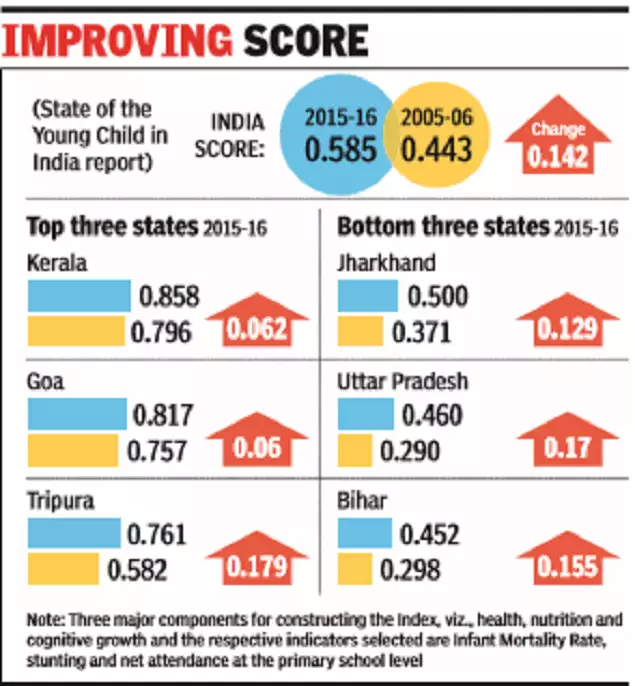State of the Young Child in India Report | 05 Sep 2020
Why in News
Recently, the State of the Young Child in India report has been released by Mobile Creches, a non-governmental organisation (NGO).
- The Young Child Outcomes Index (YCOI) and the Young Child Environment Index (YCEI) are parts of the report.
- Mobile Creches works in the field of early childhood care and development by ensuring creche services at construction sites and slum settlements across several cities.
Key Points
- Young Child Outcomes Index:

- It measures health, nutrition and cognitive growth of children in the 0-6 years age group with the help of indicators such as infant mortality rate, stunting and net attendance at the primary school level.
- It has been constructed for 2005-2006 and 2015-2016 to enable inter-state comparisons as well as provide an idea of change over time.
- Kerala, Goa, Tripura, Tamil Nadu and Mizoram are among the top five states for the well-being of children.
- Assam, Meghalaya, Rajasthan, Chhattisgarh, Madhya Pradesh, Jharkhand, Uttar Pradesh and Bihar have scores below the country’s average.
- The overall India score is 0.585 on a scale of 0-1.
- Young Child Environment Index:
- It helps to understand the policy and environment enablers that influence a child’s well-being.
- It uses five policy enablers that influence child well-being outcomes, including poverty alleviation, strengthening primary health care, improving education levels, safe water supply and promotion of gender equity.
- It was constructed for 2015–2016 only due to limitations of data availability.
- Kerala, Goa, Sikkim, Punjab and Himachal Pradesh have secured the top five positions.
- The eight states with a below-average score on the YCOI have also performed poorly on this one.
- The overall India score is 0.672.
- It helps to understand the policy and environment enablers that influence a child’s well-being.
- Analysis of Expenses:
- India spent Rs. 1,723 per child in 2018–2019 towards child nutrition, healthcare, education and other necessary protection services which is insufficient and fails to reach the entire eligible population.
- It highlights that the budgetary allocation for the Ministry of Women and Child Development has increased on a yearly basis however all the additional funds have been allocated towards nutrition delivery under the Integrated Child Development Scheme (ICDS).
- While the population of children under six years of age is 158.8 million, the ICDS covers only 71.9 million children as calculated from the total number of beneficiaries across states.
- Out of the 159 million children aged below 6 years in India, 21% are undernourished, 36% are underweight and 38% do not receive full immunisation.
- The report calls for an increase in public spending on children.
Way Forward
- The Government of India has introduced several comprehensive policies and flagship programmes like the ICDS and the National Nutrition Mission (Poshan Abhiyan) for early childhood development in the country but the need of the hour is to implement them effectively through proper coordination among various ministries.
- The recently unveiled National Educational Policy, 2020 among other schemes and programmes like Mid Day Meal Scheme, Indira Gandhi Matritva Sahyog Yojana (IGMSY), National Nutrition policy 1993, etc. towards ensuring early childhood care and comprehensive education has to be implemented properly to ensure universal access to high-quality early childhood care and education across the country in a phased manner.
- For a country, poor early childhood development could mean economic loss. The importance of this aspect of national development needs to be understood and effective steps should be taken to ensure that all children have a healthy start to their lives.
